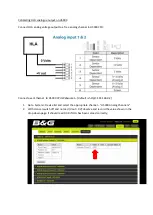
RGN-3GSF Release 5.7 User Guide, 3005-9800 REV-11
27
Table 8: RGN-3GSF SFP advanced parameters
Viewing and interpreting alarms
When a card or port alarm is active, as indicated by the card or port faceplate LED, an alarm message is
generated by the RGN-3GSF, and the message can be viewed on the card faceplate display, or through the
ONM and OSM. Details on how to view alarms in the ONM and OSM are available in the Optelian
Network
Manager (ONM) User Guide (document number 3007-9900). For information on alarms and events in TL1,
refer to the Optelian
TL1 Command Set User Guide (document number 3012-8900).
Critical, major and minor alarm status is also provided through the dry contact relays of the mounting shelf.
Default contact behavior is closed when an alarm is active. For the wiring conventions and pin assignments
of the dry contact relay card alarms, refer to the installation guide for the shelf in which the RGN-3GSF card
is installd.appropriate Optelian mounting shelf documentation.
Events are generated to provide information to the user that the system status has changed, or a system
process has occurred. Events are not displayed in the OSM, and can only be viewed in the ONM events list.
Viewing card alarms
To view the card alarm messages using the faceplate display, follow the sequence shown in Figure 10.
Figure 10: Viewing card alarms
Parameter
Value
Default
Description
SFP Information
N/A
N/A
This information is relevant to Optelian
support personnel only and may be
requested during troubleshooting
operations.
Receiver
Bandwidth Limit
Option 1 (normal rate)
Option 2
Option 1
Option 1 sets the RX limit to normal rate.
For information on Option 2, contact
Optelian customer support.
RGN-3GSF
P2
X
P1
P4
X
P3
P6
X
P5
P8
X
P7
ESC SC SEL
RGN-3GSF
Card
P1 SFP Tx
P2 SFP Rx
P3 SFP Tx
P4 SFP Rx
P5 SFP Tx
P6 SFP Rx
P7 SFP Tx
P8 SFP Rx
SFP
ESC SC SEL
Card
Alarms
Part No:
1004-2100
card SN:
31526
sw Rev:
4.1.30
SLOT#: 12
ESC SC SEL
Card Alrms
PowerA
PowerB
ModuleFail
TableFault
ESC SC SEL





































